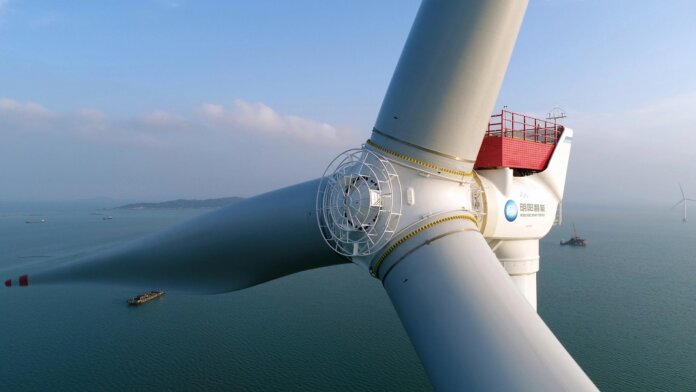In 2018, GE unveiled its Haliade-X turbine, and it has since been the largest and most powerful offshore wind turbine in the world. At 853 feet tall and with a rotor measuring 722 feet across, a single rotation of its blades can power a home for two days (that’s a home in the UK, not the US; homes here tend to be bigger energy hogs). Last year, the Haliade-X prototype located in the Netherlands set a new world record by generating 312 megawatt-hours of continuous power in one day.
But the record-setting turbine is about to get dethroned by a new, even bigger and more powerful arrival. China’s MingYang Smart Energy Group this week announced development of its MySE 16.0-242, a 16-megawatt turbine that can reportedly power 20,000 homes. Standing 866 feet tall, the turbine only has a few feet on the Haliade-X’s height, but its rotor is the differentiator at 794 feet across. Each blade is 387 feet long, and their rotation will sweep an area bigger than six soccer fields.
Let’s put some more visuals to those numbers. 866 feet is taller than the 70-story GE building in New York’s Rockefeller Center. An American football field is 360 feet long, so imagine a blade that’s even longer, and a rotor taller than the Golden Gate Bridge.
It’s hard to wrap your head around, especially when you consider that these gigantic pieces will be assembled into one unit in the middle of the ocean, then work together to produce clean energy. The company says the turbine can be anchored to the ocean floor or installed on a floating base (the proportions of which are equally hard to imagine).
Putting a man-made structure of these dimensions with moving parts in the ocean must have some sort of impact on the surrounding marine life. However, not a ton of research has been done in this area, and as offshore wind becomes a more popular source of power, it’s probably a good idea to make sure we’re not wrecking entire ecosystems by plopping turbines into their midst.
To that end, the UK’s Natural Environment Research Council launched a study this week called ECOWind. In partnership with The Crown Estate, which manages the seabed of England, Wales, and Northern Ireland, the project will collect and analyze data on offshore wind’s impact on marine ecosystems, and is scheduled to last four years.
China will want to heed the findings; it’s been the world leader in new offshore wind installations for three years running, and installed more than half the world’s offshore wind capacity last year. As demand for renewable energy sources grows, offshore wind will continue to be scaled up, both in terms of the number of turbines installed and the power generation capacity of the turbines. MingYang’s new turbine can reportedly withstand typhoon-force winds.
Founded in 2006, MingYang is a public company whose stock trades on the Shanghai exchange. Earlier this year, the company secured a contract to provide 10 turbines (of an earlier model than the 16.0-242) for the Taranto offshore wind park off the Italian coast. It will be the first offshore wind farm in the Mediterranean, and is MingYang’s first European deal.
A prototype of the MySE 16.0-242 will be built in 2022, with commercial production of the turbine scheduled to start in early 2024.
Image Credit: MingYang Smart Energy Group Co. Ltd.



